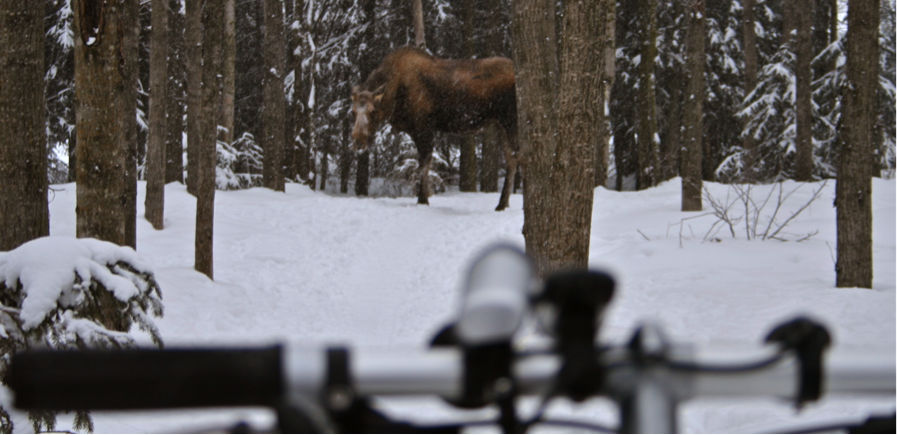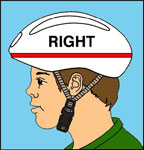Tips for Safe Bike Riding
Cycling is fun, great exercise and an economical way to get round town. Knowing how to ride safely will increase the enjoyment and reduce risks of injuries. Below is a list of safe riding tips with links to more information.
• Thank motorists who have been considerate with a wave or a nod. It brightens everyone’s day, and creates goodwill towards cyclists.
• Check your brakes, tire pressure, & chain before you ride.
• Always wear a helmet and make sure it fits properly. For more information, view NHTSA’s Fitting Your Bike Helmet Guide.
• Be visible. Wear light and bright colors during the day. Use while light in the front and red lights at the back, reflectors, and white clothing when it is dark or dusk. Click here for a short dramatic depiction of the difference between using lights and reflectors and not.
• Ride on the right side of the street.
• Children under age 9 should not ride their bikes in the street.
• Always stop and look left-right-left before turning onto a road.
• Make eye contact drivers before crossing in front of them, EVEN if you have the right of way.
• Obey all traffic signs and signals.
• Cyclists can ride on the road, on multi-use trails and on sidewalks (except for in business districts.) When riding in the street, follow vehicle traffic laws, on the sidewalk follow pedestrian laws.
• Always yield to pedestrians and give an audible signal when approaching a pedestrian.
• Use hand signal when turning or slowing down.
Anchorage Helmet Ordinance
Ordinance 9.38.200
Wearing a bicycle helmet is mandatory for any person fifteen years of age or younger when on a bicycle in public places. Public places include, but are not limited to, streets, sidewalks, pathways, trails, parking lots and skate parks.
Failure to wear a bicycle helmet or other protective headgear is a traffic violation which shall result in a warning for a first offense and which carries a fine of $25 for each subsequent offense. The fine may be waived if proof that a bicycle helmet has been obtained is presented to the Anchorage Police Department.
How To Fit a Bike Helmet
A good helmet fit is as important as wearing one… but it takes time. Allow as much as a half hour to get a proper helmet fit.
If fitting your child, don’t try to “rush” it as they are trying to go outside to ride. Do it while they’re relaxed and you have plenty of time. Then secure the adjustments so the helmet is ready for the next ride.
With a proper fit, the helmet must sit firmly and level on your head. It will not move back and forth or side to side while fastened. And the straps are snug and evenly tensioned.
The bike helmet should sit level on the head. Center the left buckle under the chin. On most helmets the straps can be pulled from the back of the helmet to lengthen or shorten the chin straps. This task is easier if you take the helmet off to make the adjustments. The side straps should form a “V” shape under and slightly, in front of the ears. After buckling the helmet, tighten the strap so NO MORE THAN ONE FINGER FITS BETWEEN THE CHIN AND STRAP.
Your helmet should fit evenly on your head between the ears and rests low on your forehead – it should only be about 1 – 2 finger widths above the eyebrows.
Does your helmet fit right?
Open your mouth wide…Big Yawn! The helmet should pull down on the head. If not, tighten the chin strap.
Shake your head “No” really hard. Does your helmet rock back more than two fingers above the eyebrows? If so, unbuckle, shorten the front strap by moving the slider forward. Also, adjust padding thickness and/or position, especially in back. Buckle, retighten the chin strap, and test again! If this doesn’t work, the helmet may be too big.
Shake your head “No” really hard. Does your helmet rock forward into your eyes? If so, unbuckle, tighten the back strap by moving the slider back toward the ear. Also, adjust padding thickness and/or position, especially in front. Buckle, retighten the chin strap, and test again!
Helmet Distribution
Contact your nearest Anchorage Fire Department Station for a bike helmet.
In partnership with Safe Kids Alaska, AFD has children’s helmets available.
Anchorage Fire Department Station Locations
Station 1
122 E. 4th Ave.
(4th & Barrow)
Station 3
1100 Airport Heights Rd.
Station 4
Tudor & MacInnes
Station 5
Spenard & McRae
Station 7
Jewel Lake & W. 88th
Station 8
6151 O’Malley Rd
Station 9
1148 Huffman Rd
Station 10
Top of Rabbit Creek Rd.
Station 12
New Seward & Dimond
Station 15
11301 Southport Dr.
Station 6
DeBarr & Patterson
Station 11
Bottom of Eagle River Rd.
Station 14
4501 Campbell Airstrip Rd.
Looking for a Ride?
Anchorage Bicycle and Helmet Laws
Off the Chain , Anchorage’s Bicycle Collective, offers a space for experts and beginners to learn bike repair and work on their bikes. Check out their website for hours and locations.
Alaska Randonneurs sponsor noncompetitive, long distance (100-1200k) self supported rides in Anchorage and around Alaska. A fantastic group of people who work hard to make riding fun, challenging and safe.
Bicycle Commuters of Anchorage sponsor and co-sponsor a variety of events throughout the year including fun Saturday winter rides, Bike First Fridays, Treats for commuters, and more. Check out their website for more information.
Single Track Advocates create and maintain single track bike trails, with a cadre of extraordinary volunteers. Their website includes maps of their trails, information about where bikes are allowed and times of work parties to help with the creation and maintenance of the trails.
Bike to Work Day is an event with multiple sponsors. The link here is to the website for the Municipality of Anchorage where you can get information about how to get involved as a planner, rider or event volunteer.
Anchorage Tour de Cure is a fun annual ride that raises money for the American Diabetes Association.




